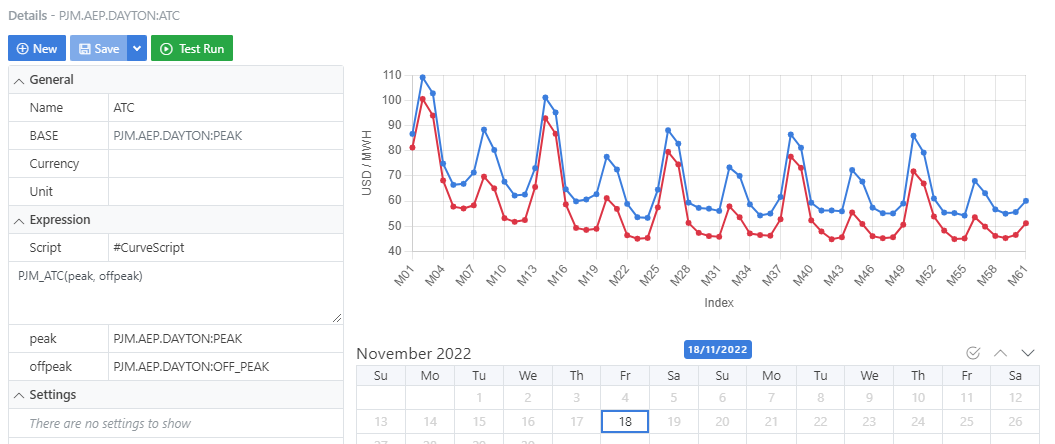
Making calendars work for you
In this blog, we show you how to create OpenDataDSL calendars using Artificial Intelligence, why it is important to use calendar rules and how to use calendars in price calculations.Creating calendars in ODSL
We can create many types of calendars in OpenDataDSL:
- Regular calendars
- Irregular/sparse calendars
- Holiday calendars
- Trading and expiry calendars
- Forward contract delivery calendars
In many of them, you can use Artifical Intelligence rules to describe how the calendar works, for example consider a business calendar where you expect an observation every working day.
Holiday calendars
We would use the following rules to tell the calendar which days are holidays and not to include them in our calendar:
H = HolidayCalendar()
// Exclude Saturday and Sunday - only use weekdays
H.addRule("Every Saturday")
H.addRule("Every Sunday")
If we want to add Christmas day to the calendar, we can add the following rule:
H.addRule("25th of December on Saturday shift -1 day and on Sunday shift 1 day")
This tells the calendar that the 25th of December is a holiday, if it lands on a Saturday, then use the Friday instead. If it lands on a Sunday, then use the Monday instead.
Using intelligent calendar rules removes the need to update calendars every year with new holiday dates thereby reducing manual tasks that can cause errors!
Expiry calendars
Expiry calendars perform date calculations to determine when a particular futures contract expires (stops trading). The determination of this date is provided by the futures exchange generally in the form of a rule.
Here is an example of a rule provided by CME for the last trade date of PJM Off-Peak calendar-month futures:
On the second to last business day of the month prior to the contract month
The rule below moves to the last working day of the previous month, then goes back 1 working day using the holiday calendar (#NERC)
RPJM = ExpiryCalendar(#NERC)
RPJM.addRule("go to the end of the previous month
align backwards then go back 1 day using calendar")
Peak and Off-peak calendars
Peak and off-peak calendars define blocks of the day which you usually want to price differently.
They consist of:
- A periodicity, e.g. 1h = hourly
- A holiday calendar defining which days are to be treated as off-peak days
- A list of hours to be excluded from the calendar
- A timezone to refer to local times
- An optional boolean parameter indicating that holiday days are to be used as full days
// PEAK - skip hours 0-5 and 22-23
SKIP_PH = [0,1,2,3,4,5,22,23]
PP = IntradayCalendar(1h, #NERC, SKIP_PH, "US/Central")
// OFF-PEAK - skip hours 6-21
SKIP_OH = [6,7,8,9,10,11,12,13,14,15,16,17,18,19,20,21]
PO = IntradayCalendar(1h, #NERC, SKIP_OH, "US/Central", true)
Using calendars
In this section we show how to use calendars to create derived prices.
Around-the-clock (ATC) price
We can use the previously created peak and off-peak calendars to create an around-the-clock price.
The calculation for the ATC price is as follows:
(peak hours * peak price) + (off-peak hours * off-peak price)
_____________________________________________________________
(peak hours + off-peak hours)
For example, if we are calculating the ATC price for January 2023, the peak and off-peak calendars tell use that we have 336 and 408 hours respectively.
start = parse("2023-01-01", "yyyy-MM-dd", "US/Central")
end = parse("2023-01-31T23:00:00", "yyyy-MM-dd'T'HH:mm:ss", "US/Central")
peakhours = PJMPEAK.getDates(start, end).size
offpeakhours = PJMOFFPEAK.getDates(start, end).size
We then need the peak and off-peak prices for January 2023 and use them in our formula:
peak = 109.15
opeak = 93.50
atc = ((peak * peakhours) + (opeak * offpeakhours)) / (peakhours+offpeakhours)
We can put this into a User Defined Function (UDF) where our input is a peak price curve and an off-peak price curve. The output is an ATC curve using the formula above.
function PJM_ATC(peak, offpeak)
set precision 2
// Read the peak and off-peak block calendars
PEAK = ${calendar:"PJMPEAK"}
OFFPEAK = ${calendar:"PJMOFFPEAK"}
// Create our output ATC curve
PJM_ATC = Curve(peak.ondate)
for pc in peak.contracts
// pc is the peak tenor price for the contract
// opc is the off-peak tenor price for the same maturity
opc = offpeak[pc.tenor]
// Get the start and end hours using the correct timezone
start = parse(pc.start, "yyyy-MM-dd", "US/Central")
end = parse(pc.end + "T23:00:00", "yyyy-MM-dd'T'HH:mm:ss", "US/Central")
// Calculate the peak and off-peak hours using the calendars
peakhours = PEAK.getDates(start, end).size
offpeakhours = OFFPEAK.getDates(start, end).size
// Perform the ATC calculation
atc = ((pc.value * peakhours) + (opc.value * offpeakhours)) / (peakhours + offpeakhours)
// Set the ATC value to the peak tenor and add to out ATC curve
pc.value = atc
PJM_ATC.add(pc)
next
end
Creating a Smart Curve
This function can now be used to create our ATC Smart Curve in the Web Portal.

More information or free trial?
Tell us about your project, and we can let you know how we can help.
Contact us at info@opendatadsl.com
